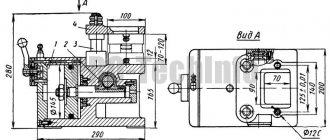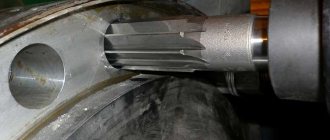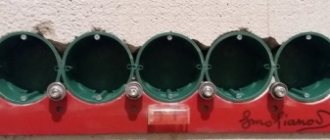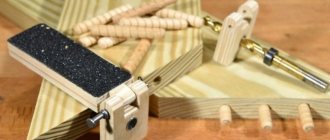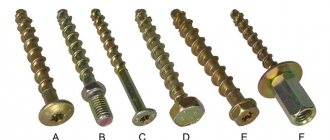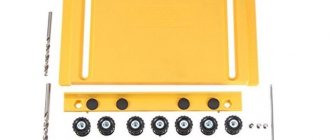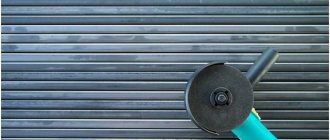Features of application in the furniture industry
Conductors and templates are needed when assembling furniture. These things will prevent you from having a common problem that occurs during drilling—the drill hitting the part at the wrong angle. Correcting such an error will take an extremely long time, in some cases it will even be impossible.
A jig for making holes will not only allow you to correctly orient the working tool, but will also prevent it from straying from the desired trajectory.
In the furniture industry, jigs and templates are used in the following cases:
- in mass production;
- when assembling structures, when it is necessary to make holes for fasteners in the parts being connected. In this case, a jig for drilling holes for dowels or confirmat is suitable;
- a jig for drilling holes at an angle is used both in such cases and when working with thin boards, for example, MDF or chipboard.
When using such a device, the assembly process will be much easier and faster; you will be able to make the necessary holes regardless of how far they should be located from the edge of the part and how wide it is.
When assembling furniture yourself, you often have to connect parts end-to-end using dowels. Holes for dowels are best made using a special jig. The peculiarity of dowels is that despite the fact that such fasteners, although outdated, are still relevant in furniture production.
The difficulty in their use lies in the fact that the axes of the holes that are made in the parts when connecting must have a right angle with each other. Accordingly, they must be placed strictly perpendicular to each other. It is difficult to do this without a special device. Therefore, if you want to achieve high quality performance, it is recommended to buy a dowel jig.
Drilling in two parts at the same time
This option is considered the most accurate and, moreover, the fastest. But in order to make a hole in two parts at the same time, you will need to fix them before drilling. To do this, you may need special clamps, clamps and other devices.
Hole Drilling Tools
In order not to mark 8 mm from the edge each time both into the layer and at the end, you can use a special device, which, by the way, is easy to make yourself.
It is a kind of wooden template with a metal sleeve for a drill inside.
It looks like this, see photo:
And this is a more professional thing:
Watch a short video on how to accurately drill holes in chipboard for confirmations and assemble furniture parts:
Other uses
Hole jigs are used not only in furniture production. Quite often they are used when you need to make a hole in a pipe or other cylindrical part. Thanks to them, you can make a high-quality hole even in a pipe with a small diameter.
Such devices are universal and easy to use, so they are also used in the following industries:
- mechanical engineering - drilling holes in different-sized workpieces based on different materials;
- construction - drilling holes in building structures;
- home communications - as already mentioned, pipe drilling and more.
Modern drilling jigs can be of different sizes and have different operating principles. Some of them are complex, so they are easier to buy. And some modifications can be made independently, especially since some serial furniture models, especially those with universal purposes, are expensive.
What is it used for?
When manufacturing and assembling elements of furniture structures, specialists have to carry out many similar actions related to both marking locations and drilling future holes. The furniture jig allows you to optimize both of these processes.
According to their functional purpose, furniture jigs can be marking and drilling. The first, as their name implies, are intended to simplify the marking of the locations of future holes. Drilling jigs used in the production of furniture structures exclude the use of marking devices.
Drilling jig for confirmations
Many people purchase a furniture template, designed for preliminary marking of the locations of future holes, in a factory-made version. However, you can make a jig for assembling furniture with your own hands. The easiest way is to make a furniture jig from a metal ruler, to which the crossbar is screwed strictly perpendicularly. This furniture template is a multi-purpose marking device that is easy to make and use. The holes through which the drilling sites will be marked are made in a metal ruler at a certain distance. So, if holes are drilled for a minifix, then the distance between them will correspond to 32 mm, and for shelf holders - 100, 200 or 300 mm.
You can make a simple furniture marking template using a regular carpenter's square as a base, in which holes are also drilled at the required distance. Such a marking device, although more functional, is less stable on the surface of the workpiece. This is its most significant drawback.
The simplest furniture template for handles is a plate with calibrated holes, on the reverse side of which a stop strip is fixed
Using a similar principle, using available materials, you can make highly specialized marking devices (for example, a jig for furniture hinges or for marking holes intended for fixing furniture handles or any other furniture fittings).
Of course, if you have your own serious furniture production and the volume of assembly operations performed is quite large, you should pay attention to professional equipment for furniture assembly. However, the cost of such furniture jigs and templates, especially if they are produced under well-known brands, is quite high.
Benefits of use
Essentially, such a jig acts as a template for making holes so that they are made as accurately as possible. They can be used for those holes whose axis is perpendicular to the surface of the workpiece, as well as for working at an angle.
This tool is an excellent alternative to sketches and manual measurements. You can place the drill strictly at the desired angle in relation to the workpiece and will not allow any deviation. The result will be especially noticeable when it comes to making deep holes.
If you use such a high-quality device for working with chipboard, then it should have the following characteristics:
- facilitate quick assembly of furniture without the need to use complex tools;
- make it possible to make several holes simultaneously without manual marking;
- significantly improve the quality of work with the drill.
Conductors are made from different materials; there are models based on plastic or organic glass. However, the best option is considered to be made of steel , which has such advantages as:
- minimal likelihood of deformation;
- the drill is directed as clearly as possible;
- no heating during operation.
Very often, overhead models based on lightweight materials that are easy to manipulate are used as furniture jigs. Many people use factory or homemade tools.
And the most qualified and experienced craftsmen no longer use a jig, since they can easily make a hole in structures on their own as accurately as possible. But not everyone can do this.
The key advantage of such a device is that the work can be performed as accurately and efficiently as possible, even by a person who does not have the proper experience. You don't have to do markings and complex preliminary calculations. You will save a lot of time and produce furniture much faster.
Advantages and disadvantages
The main advantage of conductors is that not even highly qualified specialists, but “ordinary” people at home can work with them.
And they will produce clear and precise holes (both perpendicular and inclined). You will not need to perform any calculations and markings, and this reduces how
labor intensity and work time.
The following advantages of using this type of device can be highlighted:
- The drilling jig is capable of providing perfect accuracy for both straight and inclined drilling.
- To use them, markings and preliminary scrupulous calculations are not required.
- Speeding up the assembly of furniture parts and other structures.
- The ability to drill several holes at a time without making preliminary markings.
There are much fewer disadvantages of drilling jigs; to be more specific, there is only one: the rather high price of this device. That is why some carpenters make their own jigs.
Classification of tools
Before you buy a ready-made conductor or make it yourself, you need to decide what problems you will solve with its help and only then you need to select the appropriate option in terms of design and functions.
There are a number of categories of devices that differ in their design and functional features. Here are some of them:
- overhead - such devices are applied to a part that can be processed, then it is attached to it or simply fixed manually. With their help, holes are made in various flat parts, MDF boards or chipboard;
- rotary - these templates are used when processing cylindrical parts. They are equipped with horizontal and vertical axes of rotation, so holes can be made at different angles;
- universal - such devices are suitable for small serial furniture manufacturers, where sometimes quick readjustment of the equipment used is required, they have all the functions necessary for this;
- tiltable - used when the technological procedure is carried out in several planes at once;
- sliding - such conductors do not need to be attached. Simply attach them to the surface area of the workpiece where you want to make a hole;
- fixed - they are more convenient to use, but they limit freedom of action, which is very critical when working with machines where there is only one spindle.
What is system 32 in the installation of furniture fasteners and accessories
In the production of cabinet furniture, they are increasingly moving away from standards, implementing some individually developed projects. However, there are certain design principles that remain unchanged. And at the international level.
Furniture system 32 is a general principle for standardizing the layout of furniture for further assembly. Its basis is a repeating step of 32 between the centers of the mounting holes with a distance of 37mm from the edge (taking into account the thickness of the edge).
System 32 is also followed by manufacturers of various furniture fittings and components. Thanks to this, the furniture maker does not have to think about and measure different distances in order to install guides for drawers of different types, handles of different sizes, lifting mechanisms, furniture hinges, etc. It is enough to remember a simple series of numbers (with time and growing experience in making furniture with your own hands, it is remembered like a multiplication table).
All this saves time and costs for the manufacturer in preparing furniture for assembly. System 32 also “subordinates” the settings of CNC machines, drilling and additive equipment.

